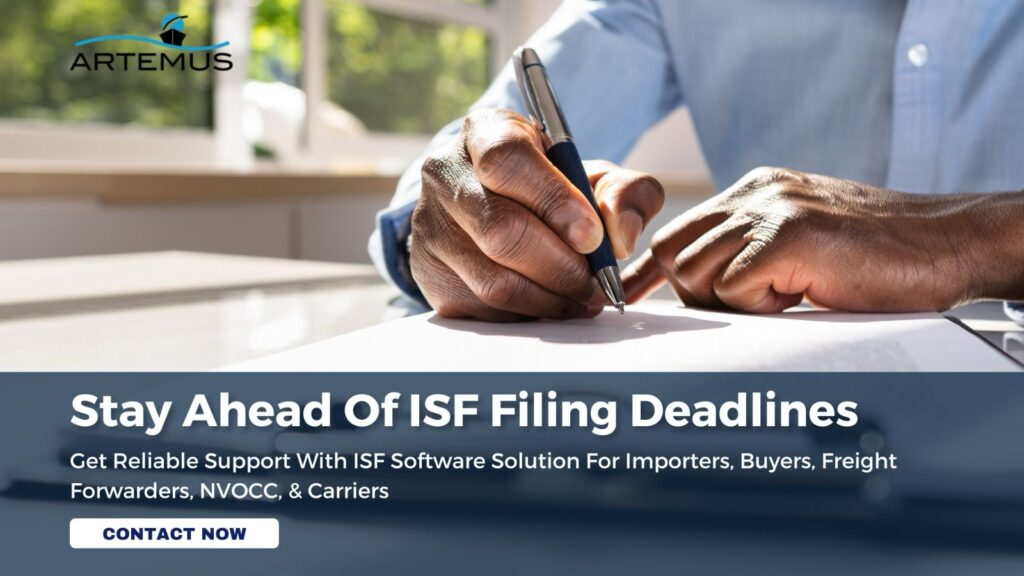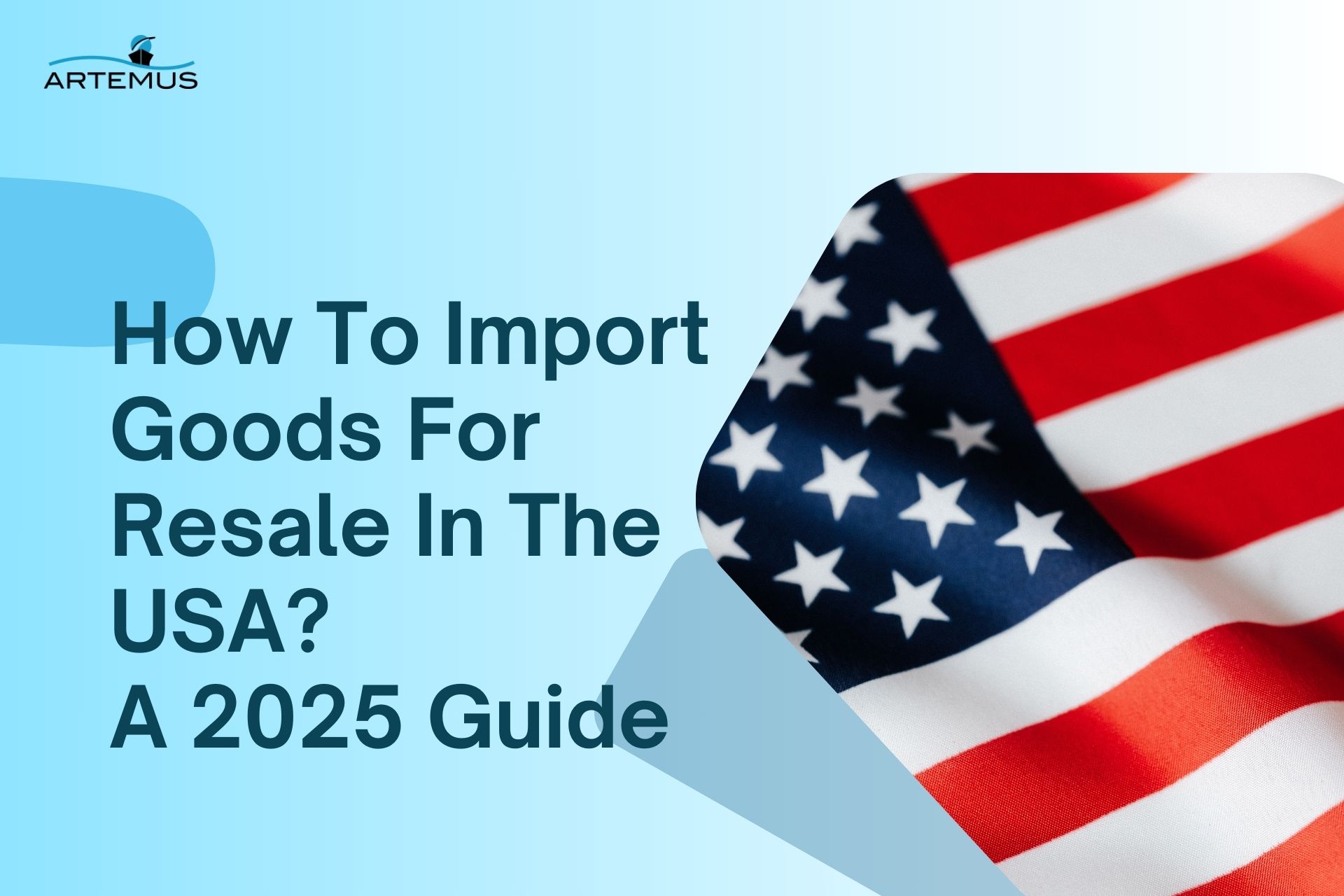
What Is Inbound Logistics & Outbound Logistics? A 2025 Guide
In the dynamic world of supply chain management, understanding the nuances of inbound and outbound logistics is crucial for operational

Navigating the intricacies of international trade requires meticulous attention to detail, especially when it comes to customs regulations. At the forefront of this regulatory landscape stands the Importer Security Filing (ISF) – a mandatory document required by U.S. Customs and Border Protection (CBP) for all ocean shipments arriving in the United States. Designed to enhance cargo security and streamline customs clearance processes, the ISF demands accurate and timely submission of key information about imported goods.
In this dynamic environment, Artemus Transportation Solutions offers an innovative ISF software solution tailored to ensure seamless compliance for importers. Join us as we delve into the nuances of the ISF Form and explore how Artemus Transportation Solutions empowers importers to thrive in the world of international trade compliance.
Table Of Contents
The Importer Security Filing (ISF) Form, also known as the 10+2 filing, is a critical document required by U.S. Customs and Border Protection (CBP) for all ocean shipments arriving in the United States. This form aims to enhance cargo security by providing CBP with advance information about the goods being imported. Understanding the components of the ISF Form is essential for importers to ensure compliance and facilitate smooth customs clearance processes.
The ISF Form starts with basic information about the Importer of Record (IOR), including their name, address, and contact details. The IOR is typically the party responsible for ensuring that the ISF is filed accurately and timely.
This section requires details about the seller or supplier of the goods being imported. It includes their name, address, and other identifying information necessary for CBP to verify the origin of the goods.
Importers must provide information about the buyer or owner of the goods. This could be the same as the Importer of Record or a different entity, depending on the terms of the sale and the shipping arrangements.
The ISF Form requires details about the party to whom the goods will be shipped. This could be a warehouse, distribution center, or any other location where the goods will be delivered upon arrival in the United States.
Importers must provide information about the manufacturer or supplier of the goods, including their name, address, and other relevant details. This helps CBP verify the origin of the goods and ensures compliance with trade agreements and regulations.
Importers must accurately declare the country of origin for the goods being imported. This is crucial for determining applicable duties, taxes, and trade preferences under various trade agreements.
The ISF Form requires importers to provide the Harmonized Tariff Schedule (HTS) codes for the goods being imported. HTS codes classify products for customs and tariff purposes and are essential for accurate duty assessment.
Importers must specify the location where the goods were stuffed into the shipping container. This information helps CBP verify the integrity of the cargo and ensures compliance with security regulations.
If the goods were stuffed into the container by a third-party consolidator, importers must provide their details. This helps CBP track and verify the movement of cargo and ensures transparency in the supply chain.
Importers must provide the Manufacturer Identification Number (MID) assigned by CBP for the manufacturer of the goods, if applicable. This unique identifier helps CBP verify the legitimacy of the manufacturer and ensures compliance with trade regulations.
Related: ISF Declaration: Meaning, Purpose, Timeline, & Process

The Importer Security Filing (ISF) Form, also known as the 10+2 filing, is a mandatory requirement enforced by U.S. Customs and Border Protection (CBP) for all ocean shipments arriving in the United States. Understanding who needs to file the ISF Form is essential for importers and other parties involved in international trade to ensure compliance with CBP regulations and avoid potential penalties and delays in the customs clearance process.
The primary responsibility for filing the ISF Form rests with the importer of record (IOR). The importer of record is typically the owner, purchaser, or consignee of the imported goods and is legally responsible for ensuring compliance with all customs regulations.
NVOCCs, which are entities that consolidate and coordinate shipments from multiple shippers for transport by ocean carriers, may also be required to file the ISF Form on behalf of their customers. When acting as the carrier and the importer of record, NVOCCs assume responsibility for submitting accurate ISF information to CBP.
Freight forwarders, who arrange the transportation of goods on behalf of importers, may be responsible for filing the ISF Form if they are listed as the importer of record on the bill of lading. In such cases, freight forwarders must ensure timely and accurate submission of ISF information to CBP.
Customs brokers, who assist importers with customs clearance procedures, may also play a role in filing the ISF Form on behalf of their clients. However, the ultimate responsibility for ISF compliance lies with the importer of record, even if a customs broker handles the filing process.
While the primary obligation for ISF filing rests with the importer of record, ocean carriers are required to transmit certain vessel-related information to CBP at least 24 hours before the cargo is loaded onto the vessel. This information is known as the vessel stow plan and container status messages, which are part of the larger Automated Manifest System (AMS) filing.
It’s important to note that there are limited exceptions to the ISF filing requirement. For example, shipments consisting entirely of goods intended for immediate exportation or transportation in-bond through the United States may be exempt from ISF filing. Additionally, certain government agencies may be exempt from filing ISF for specific types of cargo, such as military equipment or diplomatic shipments.
Related: ISF Fees (Import Security Filing): When & How To Pay?
Filing the Importer Security Filing (ISF) Form, also known as the 10+2 filing, is a crucial step for importers and other parties involved in international trade to comply with U.S. Customs and Border Protection (CBP) regulations and facilitate the smooth clearance of ocean shipments entering the United States. Understanding the process of filing the ISF Form is essential for ensuring accuracy, timeliness, and compliance with CBP requirements.
Before initiating the ISF filing process, gather all necessary information required for completing the form. This includes details such as the manufacturer and supplier information, buyer and consignee details, container stuffing location, Harmonized Tariff Schedule (HTS) codes for each product, and other pertinent shipment-related information.
Determine the method of filing that best suits your needs and capabilities. ISF filings can be submitted electronically through the Automated Broker Interface (ABI) system, by using a CBP-approved software vendor, or by employing the services of a licensed customs broker or freight forwarder. Choose the method that aligns with your resources and preferences.
If filing electronically through ABI or a CBP-approved software vendor, obtain a filer code from CBP. This unique identifier is necessary for accessing the CBP system and submitting ISF filings. Ensure that your filer code is up-to-date and properly activated before initiating the filing process.
Using the gathered information, complete the ISF Form accurately and thoroughly. Input all required data fields, including but not limited to manufacturer and supplier details, buyer and consignee information, country of origin, container stuffing location, consolidator details, HTS codes, and bill of lading numbers.
Before submitting the ISF Form, thoroughly review and validate all entered information for accuracy and completeness. Ensure that all data fields are correctly populated and comply with CBP requirements to avoid potential errors or discrepancies that could lead to penalties or delays in customs clearance.
Once the ISF Form is complete and validated, submit the filing through the selected method. If filing electronically, follow the instructions provided by the chosen filing platform or software vendor to transmit the ISF data to CBP securely. Double-check that the filing has been successfully submitted and received by CBP.
After submitting the ISF filing, monitor the status of the filing and any responses or messages received from CBP. Be proactive in addressing any issues or requests for additional information promptly to ensure timely resolution and compliance with CBP regulations.
Keep detailed records of all ISF filings, including confirmation receipts, responses from CBP, and any related documentation. Maintain these records in an organized manner for future reference, and audit purposes, and to demonstrate compliance with CBP requirements.
Related: How To Check ISF Filing Status? A Step-By-Step Guide
Implementing best practices for ISF compliance helps organizations navigate complex regulations and maintain the integrity of the supply chain. Here are some key best practices to consider:
1. Establish Robust Internal Processes: Implement clear and well-defined internal processes and procedures for ISF compliance within your organization. Assign responsibility to specific individuals or teams for gathering required information, completing ISF filings accurately and timely, and monitoring compliance status. Regularly review and update these processes to incorporate changes in regulations or business practices.
2. Utilize Technology for Efficiency: Leverage technology solutions and automation tools to streamline the ISF filing process and enhance efficiency. Invest in CBP-approved software platforms or electronic data interchange (EDI) systems that enable electronic submission of ISF filings and provide features such as data validation, error checking, and automated notifications. Utilizing technology can help reduce manual errors, improve data accuracy, and expedite customs clearance.
3. Stay Updated on Regulations: Stay abreast of changes and updates to ISF regulations and requirements issued by U.S. Customs and Border Protection (CBP). Regularly review official CBP guidance, notices, and trade publications to ensure compliance with the latest regulatory developments. Consider participating in industry seminars, webinars, or training sessions to deepen your understanding of ISF compliance and stay informed about best practices.
4. Maintain Accurate Data Records: Maintain comprehensive and accurate records of all ISF filings, supporting documentation, and communication with CBP or other stakeholders. Create a centralized repository or database to store ISF-related information in an organized and easily accessible format. Retain records for the required retention period specified by CBP regulations, typically five years from the date of entry, to facilitate audits, inquiries, or verifications.
5. Proactively Address Non-Compliance Issues: Take proactive measures to address and rectify any instances of non-compliance or discrepancies identified during the ISF filing process. Promptly respond to CBP requests for additional information or clarification, and collaborate with relevant stakeholders, such as customs brokers or freight forwarders, to resolve issues effectively. Implement corrective actions and preventive measures to minimize the risk of recurrence and ensure ongoing compliance with ISF regulations.
Related:ISF Bond Cost Breakdown & Management For Import Success

Artemus Transportation Solution is proud to introduce its latest offering: an ISF software solution designed to streamline compliance for importers and enhance the efficiency of customs clearance processes. With cutting-edge ISF software, importers can easily and accurately file Importer Security Filings (ISF) with U.S. Customs and Border Protection (CBP), ensuring seamless compliance with regulatory requirements.
This intuitive platform simplifies the ISF filing process, automates data validation, and provides real-time updates on filing status, enabling importers to proactively address any issues and avoid potential penalties or delays.
Artemus Transportation Solution’s ISF software empowers importers to navigate complex customs regulations with confidence, optimize supply chain operations, and focus on their core business activities. Experience hassle-free ISF compliance and maximize efficiency with Artemus Transportation Solution’s innovative software solution.
Related: Late ISF Filing: What To Do If Missed The Deadline?
The ISF Form, or Importer Security Filing, is a mandatory document required by U.S. Customs and Border Protection (CBP) for ocean shipments entering the United States. It provides advanced information about imported goods to enhance cargo security and facilitate customs clearance processes.
The importer of record (IOR) is primarily responsible for filing the ISF (Importer Security Filing) to U.S. Customs and Border Protection (CBP) for every ocean-bound shipment arriving in the United States.
The full form of ISF is “Importer Security Filing,” a mandatory document required by U.S. Customs and Border Protection (CBP) for overseeing ocean shipments as they enter the United States.

The Importer Security Filing (ISF) serves as a critical component of the international trade process, ensuring the security and efficiency of ocean shipments entering the United States. By providing advance information about imported goods to U.S. Customs and Border Protection (CBP), the ISF helps enhance cargo security, facilitate customs clearance processes, and mitigate potential risks to the supply chain.
Importers play a crucial role in complying with ISF requirements, as timely and accurate filing is essential to avoid penalties, delays, and disruptions to business operations. Embracing best practices for ISF compliance, staying informed about regulatory updates, and leveraging technology solutions can empower importers to navigate the complexities of customs regulations effectively.

In the dynamic world of supply chain management, understanding the nuances of inbound and outbound logistics is crucial for operational

In today’s interconnected world, businesses rely heavily on global trade to expand their markets, access new resources, and drive growth.

Importing goods for resale in the USA presents a lucrative business opportunity, but navigating the complexities of U.S. customs regulations,
Get In Touch
Artemus’ Software Solutions for ISF, AMS, Japan AFR, eManifest Canada, & Panama B2B filings.